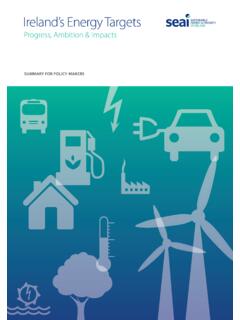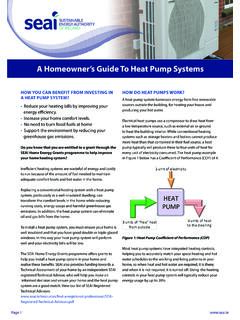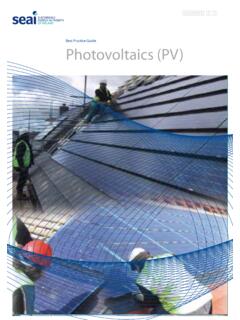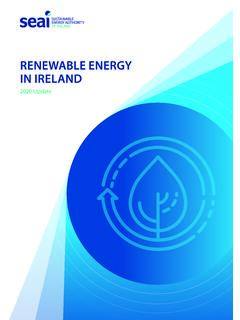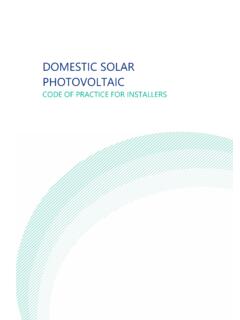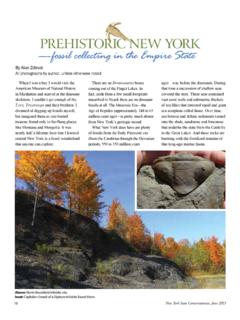Transcription of Energy in Ireland 2016 - SEAI
1 Energy in Ireland 1990 20152016 ReportEnergy in Ireland 1990 2015 2016 Report1 Energy in Ireland 1990 20152016 ReportReport prepared byMartin Howley and Mary Holland Energy Policy Statistical Support UnitNovember 20162 Energy POLICY STATISTICAL SUPPORT UNITS ustainable Energy Authority of IrelandThe Sustainable Energy Authority of Ireland s (SEAI) mission is to play a leading role in transforming Ireland into a society based on sustainable Energy structures, technologies and practices. To fulfil this mission SEAI aims to provide well-timed and informed advice to Government, and deliver a range of programmes efficiently and effectively, while engaging and motivating a wide range of stakeholders, and showing continuing flexibility and innovation in all activities. SEAI s actions will help advance Ireland to the vanguard of the global green technology movement, so that Ireland is recognised as a pioneer in the move to decarbonised Energy Policy Statistical Support Unit (EPSSU)SEAI has a lead role in developing and maintaining comprehensive national and sectoral statistics for Energy production, transformation and end-use.
2 This data is a vital input in meeting international reporting obligations, for advising policymakers and informing investment decisions. Based in Cork, EPSSU is SEAI s specialist statistics team. Its core functions are to: Collect, process and publish Energy statistics to support policy analysis and development in line with national needs and international obligations; Conduct statistical and economic analyses of Energy services sectors and sustainable Energy options; Contribute to the development and promulgation of appropriate sustainability gratefully acknowledges the cooperation of the all the organisations, agencies, Energy suppliers and distributors that provided data and responded to questionnaires throughout the year. Sustainable Energy Authority of IrelandRepRoduction of the contents is peRmissible pRovided the souRce is IN Ireland 1990 fi 2015 ff2016 REPORT ForewordAt time of writing, the 2015 Paris Agreement has come into force, having met the double threshold of ratification by more than 55 countries, representing at least 55% of global emissions.
3 A testament to how seriously the world and society now takes the threat of climate change is the fact that this took a fraction of the eight years required to get the Kyoto Protocol report provides both a milestone record of our progress in reducing and decarbonising our Energy use, while also setting a baseline for future efforts. The deadline for our 2020 targets is approaching at pace, and we are now seeing a slow crystallisation of what our 2030 targets will look this year s report, there are very clear signals of the challenge ahead for Ireland . With strong economic growth in 2015, overall Energy use increased by almost 5% and related emissions by almost 6%, the first time Energy use grew to any great extent since 2010. So even though we have had some success in decoupling Energy use from economic growth, it is apparent that further work is needed to achieve our evolving decarbonisation regard to renewable Energy , 2015 saw Ireland reach just over half way mark towards our 2020 renewable Energy targets.
4 Similar to our efforts on reducing Energy demand, the next phase of decarbonising Energy supply will be increasingly challenging. Through a range of approaches, a more widespread understanding of the need for renewables and support for their delivery must be , we must maintain momentum in the electricity sector, and develop greater momentum in the heat and transport sectors. In a political and economic era of rapid change, success will only be achieved by countries which are agile and adaptable to change. As we build new platforms and mechanisms that will bring us to 2030, it is essential that we engage and activate the society who will need to accommodate a rate of change not previously is committed to the provision of robust and transparent data, such as that contained in this report, to ensure that the policy formation, decision-making and our Energy transition are Gannon, Chief Executive, Sustainable Energy Authority of IrelandJim Gannon4 Energy POLICY STATISTICAL SUPPORT UNITH ighlightsHighlights the year 2015 Energy use grew for the first time to any great extent since 2010.
5 In 2015, overall Energy use increased by , with the economy growing strongly. Energy -related CO2 emissions increased by in 2015. When compared with 2005, Energy -related CO2 emissions have fallen by 19%. Energy -related emissions account for approximately 60% of Ireland s total greenhouse gas (GHG) emissions. Consumption of all fuels increased in 2015 with the exception of peat, biomass and non-renewable wastes. Ireland s Energy import dependency increased to 88% in 2015 (from 85% in 2014). The cost of all Energy imports to Ireland was approximately billion, down from billion in 2014 due mainly to falling oil and gas import Final consumption of electricity increased by to 29 TWh with a increase in the fuel inputs. Renewable electricity generation, consisting of wind, hydro, landfill gas, biomass and biogas, increased to of gross electricity consumption in 2015.
6 In 2015, wind generation accounted for of the electricity generated and was the second largest source of electricity generation after natural gas. The use of renewables in electricity generation in 2015 reduced CO2 emissions by Mt and avoided 286 million in fossil fuel imports. The carbon intensity of electricity fell by 49% since 1990, to a low of 456 g CO2/kWh in 2014. However, in 2015 it increased by , to 468 g CO2/kWh, primarily as a result of the increase in coal used for towards Targets The contribution of renewables to gross final consumption (GFC) was in 2015, compared to a 2020 target of 16%. This avoided million tonnes of CO2 emissions and 426 million of fossil fuel imports. In 2015, with five years to go, Ireland was just over halfway towards each of the separate targets for contributions of renewable Energy in electricity, transport and heat.
7 The average emissions of new cars purchased in 2015 was g CO2/km, which is below the 2015 EU target for car manufacturers of 130 g CO2/km. Energy -related CO2 emissions in those sectors outside the EU Emissions Trading Scheme (ETS), which covers transport, heating in households, buildings and small industry, were 17% below 2005 levels in 2015 but increased by in 2015. The target for non-ETS CO2 emissions is to be 20% below 2005 levels by Highlights Transport continues to dominate as the largest Energy consuming sector, with a share of 42% in 2015. Transport Energy use increased by in 2015, with air travel showing the strongest growth in Energy use of the transport modes, with a 13% increase on 2014. More than three quarters (78%) of all new private cars purchased to date in 2016 were in the A label emissions band.
8 In 2015 industry Energy use increased by , and was 10% lower than the peak in 2006. Between 1990 and 2015, industrial Energy consumption increased by 39% while value added increased by 506%. Residential Energy use increased by in 2015 relative to 2014. When corrected for weather effects 2015 was a colder year than 2014 the increase in Energy use was In 2015 the average household emitted tonnes of CO2 of which 61% came from direct fuel use in the home and the remainder from electricity use. Final Energy use in the commercial and public services sector increased by in 2015 on a weather corrected basis it decreased by IN Ireland 1990 fi 2015 ff2016 REPORT Table of ContentsForeword 3 Highlights 41 Introduction 92 Energy Trends Energy Supply Energy Use by Mode of Application Energy Balance for 2015 Energy Demand Heating Degree Days Energy Intensities Electricity Generation Combined Heat and Power Primary Fuel Inputs into Electricity Generation Electricity Demand Energy .
9 Weather and the Economic Downturn 283 Key Policy Issues Progress towards Renewable Energy Targets Electricity from Renewable Energy Sources (RES-E) Heat from Renewable Energy Sources (RES-H) Transport Energy from Renewable Sources (RES-T) CO2 Displacement and Avoided Fuel Imports Greenhouse Gas Emissions Targets Transboundary Gas Emissions Energy Security Cost Competitiveness Energy Prices in Industry 454 Sectoral Indicators Industry Industry Energy Intensity Transport Transport Energy Demand by Mode Private Car Transport CO2 Emissions of New Private Cars Energy Efficiency of New Private Cars Private Car Average Annual Mileage Heavy Goods Vehicle Activity Residential Unit Consumption of the Residential Sector Commercial and Public Services Energy Intensity of the Commercial and Public Services Sector Public Sector Developments 725 Energy Statistics Revisions and Corrections 74 Glossary of Terms 76 Energy Conversion Factors 77 Sources
10 79 References 80 Energy Balance 2015 826 Energy POLICY STATISTICAL SUPPORT UNITT able of FiguresFigure 1 Index of Gross Domestic Product, Total Primary Energy Requirement (TPER) and Energy -Related CO2 10 Figure 2 Total Primary Energy Requirement 12 Figure 3 Total Primary Energy Requirement by Sector 13 Figure 4 Primary Energy by Mode of Application 14 Figure 5 Energy Flow in Ireland 2015 15 Figure 6 Total Final Consumption by Fuel 16 Figure 7 Total Final Energy Consumption by Sector 17 Figure 8 Heating Degree Day Trend 2015 versus 2014 18 Figure 9 Primary, Final and Electricity Intensity 19 Figure 10 Flow of Energy in Electricity Generation 2015 20 Figure 11 Flow of Energy in Electricity Generation 2015 Outputs by Fuel 21 Figure 12 Efficiency of Electricity Supply 22 Figure 13 Gas Generation Gross Efficiency and Renewable Generation Penetration 22 Figure 14 CO2 Emissions per kWh of Electricity Supplied.

